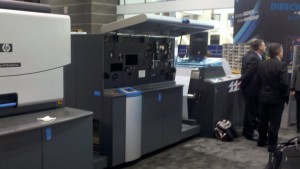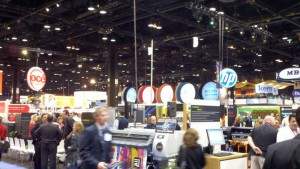Oh the times they are a changin’

“Well I guess this digital thing isn’t just a trend,” I overheard "Fred" say as I walked the floor of Graph Expo last week in Chicago. For those who don’t know, Graph Expo is the biggest annual Print and Graphic Communication trade show in North America. For "Fred" and other career printers like him, this year’s expo must have been a total cultural shock. Certainly, the past two years have not been easy on the printing industry. However, what was glaringly obvious is that out of that struggle has emerged a bright new digital future for the industry.
Two years ago when I attended Graph Expo, the buzz at the show revolved around the Heidelberg booth. Heidelberg was showcasing the advances they had made in automated production and featured the biggest, fastest, loudest, and shiniest “heavy iron” on the trade show floor (or so it seemed to me). This year, Heidelberg did not attend Graph Expo. Instead, Hewlett Packard (HP) occupied their normal marquee place at the entrance to Graph Expo.
Digital Printing is the brave new world of the printing industry. It reflects not only a change in print production, but on a greater level a profound change in the print market itself. As the Internet continues to become more accessible, personalized, and relevant we are seeing those same themes become reflected in marketing and media as a whole. Digital Print has made possible the focused, localized, and personal print marketing campaign. The point is, print is not dead, it is adapting and becoming more sophisticated.

In addition to the wide array of digital presses being showcased were a number of software vendors demonstrating powerful tools to help facilitate print into a cross-media marketing campaign. As more and more printers adjust their position to become a full-service marketing service provider (MSP), this type of software becomes a tremendously valuable tool. Programs like XM Pie and MindFire will help allow the MSP to intelligently target specific markets and consumer groups, create segmented interactive print and online marketing collateral, and give powerful feedback and analysis with which to make intelligent adjustments to a specific campaign. While programs like Constant Contact have applied these capabilities to the realm of Email marketing for quite some time, these other programs allow and MSP to manage ALL parts of a marketing campaign including Email, Social Media, interactive print, and direct mail.

With the focus of the print industry turning to the realm of marketing services, a new sales model needs to take shape. A printer or MSP can not expect to win over customers simply by promoting the equipment or capabilities they have. After all, nobody buys print simply for the purpose of having print-there is a specific purpose in mind. Instead, sales staff must gain a better appreciation of their customer’s perspective and purpose in order to help them realize their end strategy. The MSP needs to be more than a supplier; it needs to be a partner. By learning to ask the right questions, and actively seeking to help a customer reach their marketing goals, this position can be filled. A printer or MSP that can help shape a customers marketing strategy and be seen as an expert resource will be one that will realize long-term success, not only for themselves but for there customers as well.
My days at Graph Expo were an interesting study in contrast of the divide taking shape in the print industry. On one side were the old guard; industry veterans (most of whom dressed “to the nines”) clumped together around the “iron” vendors seemingly disturbed by the changes going on around them. There was even a dedicated area of the trade show for Newsprint, which seemed to be less of a showcase for emerging newspaper technology as much as a traditionalist stand against change. On the flip side were the people like myself; young, technology-minded, huddled around the digital equipment and software vendors. These examples are of course gross overgeneralizations, however they bring up an important point. In order to survive, the old dogs need to be willing to learn new tricks. I understand that this is not an easy thing to say or do, but it is necessary nonetheless. Print, as part of the greater communications industry, is still an enormously lucrative and healthy industry. It just looks a lot different than it did only a short time ago.


